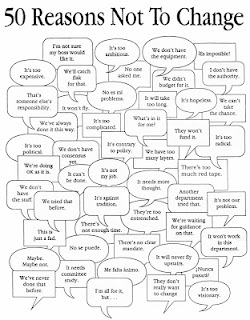A635.6.3.RB
EcoSeagate
For
this blog, I have been asked to review the OD Application found on page 274 of
my textbook, “An Experiential Approach to Organization Development” by Donald
R. Brown and answer the following three questions:
- Do you see value in the EcoSeagate team development process?
- Why
would something like this be necessary in a high-performing organization?
- Could
your organization benefit from a similar activity?
According
to Seagate’s website, “Seagate is the global leader in data storage solutions,
developing amazing products that enable people and businesses around the world
to create, share and preserve their most critical memories and business data.
Over
the years the amount of information stored has grown from megabytes all the way
to geopbytes, confirming the need to successfully store and access huge amounts
of data. As demand for storage technology grows the need for greater efficiency
and more advanced capabilities continues to evolve.
Today
data storage is more than just archiving; it’s about providing ways to analyze
information, understand patterns and behavior, to re-live experiences and
memories. It’s about harnessing stored information for growth and innovation.
Seagate is building on its heritage of storage leadership to solve the
challenge of getting more out of the living information that’s produced every
day. What began with one storage innovation has morphed into many systems and
solutions becoming faster, more reliable and expansive. No longer is it just
about storing information; it is about accessing and interpreting information
quickly, accurately and securely.” (Seagate, 2016)
In
Brown’s text, he lays out the OD Application: EcoSeagate and Team Development, “Seagate
Technology, a manufacturer of computer hard drives, each year spends $2 million
on one outdoor lab experience. It calls the lab EcoSeagate and it is where the
company brings together 200 of its employees from around the world to a team development
meeting in the desolate mountains and glaciers of New Zealand, close to where
Lord of the Rings was filmed. With such a foreign and intimidating environment,
everyone feels off balance and no one has an advantage over anyone else.
Prework for the participants is a good deal of physical conditioning and required
reading of The Five Dysfunctions of a Team: A Leader- ship Fable .CEO Bill
Watkins started EcoSeagate in 2000, soon after becoming president of Seagate.
Watkins says, ‘They called it Slavegate. People got fired all the time. The CEO
had a grenade on his desk.’ Watkins figured that if he showed the value of teamwork
away from work, the participants would transfer the experience back into their
work. He says, ‘I learned a lesson a long time ago in the Army. Nobody really
wants to die for their god. No one wants to die for their country. Absolutely
no one wants to die for money. But people put their lives on the line for the respect
of their platoon mates.’ The participants, who are selected from more than
2,000 applicants, consist of a cross-section of the company: top executives,
managers, engineers, and factory workers. The 200 participants are split into
40 teams of 5 people. The composition of the teams is made in advance with
consideration given to having a mix that includes physical ability, level
within the company, sex, nationality, and personality. For five days, the teams
go through a variety of competitive events that encourage each team to learn
how to work together. EcoSeagate culminates in a 40-kilometer adventure race
through a course consisting of biking, climbing, traversing unknown terrain
with a vague map, kayaking, traversing canyons on cables, and running. Watkins
has not been able to prove or point to quantitative results of EcoSeagate. He
has never won his own race and has even come in dead last. Through the years,
he has received criticism from stockholders for the event, and though he cannot
precisely measure the results, to him there are obvious signs that it is
working. ‘The only thing you know for sure,’ he says, ‘is that if you do
nothing, then nothing will happen, and nothing will change.’” (Brown, 2011, pg.
274)
After
reading about Seagate and watching the two videos, I can honestly say that I
would love to experience this type of team building.
In
the two videos, employees are broken down into teams and are given colored
wardrobe and banners and a bird mascot such as the tui which is native to New
Zealand. These teams then participate in
competition events such as biking, running, kayaking, scavenger hunt and
more. They are also challenged to
overcome their fears by participating in high ropes and rappelling. After each competition, they gather together
and perform tribal chants and dances.
These events help teams develop their teamwork skills, build respect and
trust for each other, resolve conflict, become more committed and be
accountable for their actions and deeds.
I
certainly see great value in Seagate’s team development program. However, it must be quantified to show the
stakeholders and shareholders that it is viable program and improves the
overall performance of the organization increasing the “bottom-line”.
Team
building events in high-performance organizations is paramount. During my 27-year Army career, team building
was part of culture and helped create great organizational cohesiveness and
performance.
In
secondary education I could see benefit and this type of practice. Teachers are just not cohesive. Each teacher does his or her own thing. I believe by building a team instead of a
group of individuals, education would improve for students and the end result
would be an overall culture of teamwork with a common goal.
References
Seagate. (2016). About Seagate. Retrieved from http://www.seagate.com/about-seagate/
Brown, D. R. (2011). An experiential approach to
organization development. (8th Ed). Prentice Hall: Upper Saddle
River, NJ
Chao, M. (2008, April 25). Eco Seagate 2008 1/3.
[Video File]. Retrieved from https://www.youtube.com/watch?v=zCOfOFMiLtE
Chao, M. (2008, April 26). Eco Seagate 2008 2/3.
[Video File]. Retrieved from https://www.youtube.com/watch?v=Etwuap-_Azk&spfreload=10



